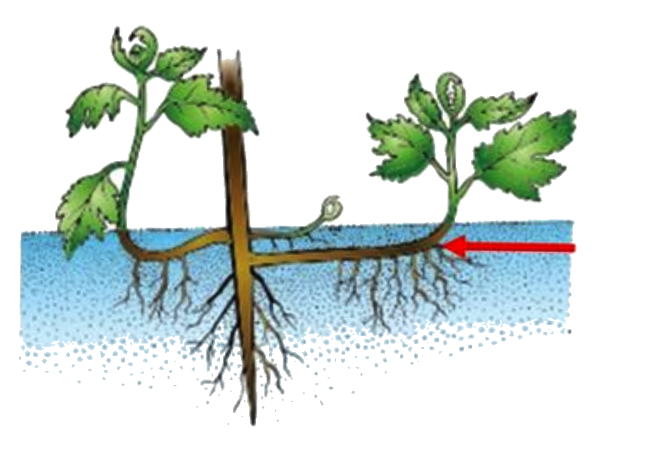Write a note on modifications of underground stems.
Step-by-Step Solution:
1. Definition of Underground Stems:
Underground stems are parts of the plant that grow below the soil surface. They serve various functions, including storage of nutrients and vegetative reproduction.
2. Types of Modifications:
Underground stems can be modified into several structures, primarily for storage and survival. The main types include:
- Rhizomes: These are horizontal underground stems that can produce new shoots and roots. They store food and help the plant survive adverse conditions. Examples include ginger and turmeric.
- Tubers: These are swollen underground stems that store starch and nutrients. They have buds (eyes) from which new plants can grow. A common example is the potato.
- Corms: These are short, swollen underground stems that store food. They are solid and can produce new shoots. An example is the taro.
- Bulbs: These are rounded underground storage organs consisting of a short stem surrounded by fleshy leaves. They store nutrients and can produce new plants. An example is the onion.
3. Functions of Modifications:
- Storage of Nutrients: The primary function of these modifications is to store carbohydrates and other nutrients, which can be utilized during unfavorable conditions.
- Vegetative Reproduction: Many of these structures can give rise to new plants, allowing for asexual reproduction.
- Survival: These modifications help the plant survive during adverse conditions such as drought or extreme temperatures.
4. Conclusion:
Modifications of underground stems are crucial for the survival and propagation of many plants. They enable plants to store essential nutrients and reproduce without the need for seeds.
Underground stems are parts of the plant that grow below the soil surface. They serve various functions, including storage of nutrients and vegetative reproduction.
Underground stems can be modified into several structures, primarily for storage and survival. The main types include:
- Rhizomes: These are horizontal underground stems that can produce new shoots and roots. They store food and help the plant survive adverse conditions. Examples include ginger and turmeric.
- Tubers: These are swollen underground stems that store starch and nutrients. They have buds (eyes) from which new plants can grow. A common example is the potato.
- Corms: These are short, swollen underground stems that store food. They are solid and can produce new shoots. An example is the taro.
- Bulbs: These are rounded underground storage organs consisting of a short stem surrounded by fleshy leaves. They store nutrients and can produce new plants. An example is the onion.
- Storage of Nutrients: The primary function of these modifications is to store carbohydrates and other nutrients, which can be utilized during unfavorable conditions.
- Vegetative Reproduction: Many of these structures can give rise to new plants, allowing for asexual reproduction.
- Survival: These modifications help the plant survive during adverse conditions such as drought or extreme temperatures.
Modifications of underground stems are crucial for the survival and propagation of many plants. They enable plants to store essential nutrients and reproduce without the need for seeds.
Topper's Solved these Questions
- MORPHOLOGY OF FLOWERING PLANTS BOOK - ICSECHAPTER - MORPHOLOGY OF FLOWERING PLANTS EXERCISE - NCERT TEXTBOOK QUESTIONS WITH SOLUTIONS
25 Videos
- MORPHOLOGY OF FLOWERING PLANTS BOOK - ICSECHAPTER - MORPHOLOGY OF FLOWERING PLANTS EXERCISE - REVIEW QUESTIONS (IV. SHORT ANSWER TYPE QUESTIONS)
17 Videos
- MORPHOLOGY AND ANATOMY OF DIFFERENT SYSTEM OF COCKROACH BOOK - ICSECHAPTER - MORPHOLOGY AND ANATOMY OF DIFFERENT SYSTEM OF COCKROACH EXERCISE - Long Answer type Questions
6 Videos
- NEURAL CONTROL AND CO-ORDINATION BOOK - ICSECHAPTER - NEURAL CONTROL AND CO-ORDINATION EXERCISE - NCERT EXERCISES WITH ANSWER (DIFFERENTIATE BETWEEN)
11 Videos
Similar Questions
Which is not a modification of stem ?
View SolutionWrite short notes on Dictyosome
View SolutionWrite a note on biotic community
View SolutionWrite short notes on Diffusion.
View SolutionWrite a short note on albinism.
View SolutionPotato is (underground) stem because it
View SolutionSelect an incorrect statement wrt modifications of stem
View SolutionDescribe the various types of underground stems giving suitable examples. How will you ascertain that the underground part is a stem or a root ?
View SolutionWhich type of bud is represented by the eyes in the modified underground stem of the potato tuber
View SolutionWhich of these plants have a modification of stem as indicated by the red arrow , in this diagram ?

View Solution
